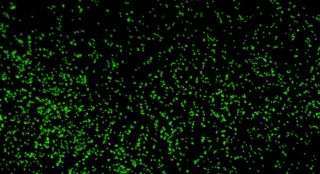
A magnified image shows the revived microbes.
Microbes found themselves buried in the dirt 101.5 million years ago, back before even Tyrannosaurus rex when Earth’s biggest meat-eating dinosaur, called Spinosaurus roamed the planet. Time passed, continents shifted, oceans rose and fell, great apes emerged, and eventually human beings evolved with the curiosity and skills to dig up those ancient cells. And now, in a Japanese lab, researchers have brought the single-celled organisms back to life.
Researchers aboard the drill ship JOIDES Resolution collected sediment samples from the bottom of the ocean 10 years ago. The samples came from 328 feet (100 meters) below the 20,000-foot-deep (6,000 m) bottom of the South Pacific Gyre. That’s a region of the Pacific Ocean with very few nutrients and little oxygen available for life to survive on, and the researchers were looking for data on how microbes get along in such a remote part of the world.
“Our main question was whether life could exist in such a nutrient-limited environment or if this was a lifeless zone,” Yuki Morono, a scientist at the Japan Agency for Marine-Earth Science and Technology and lead author of a new paper on the microbes, said in a statement. “And we wanted to know how long the microbes could sustain their life in a near-absence of food.
Their results indicate that even cells found in 101.5 million-year-old sediment samples are capable of waking up when oxygen and nutrients become available.
“At first, I was skeptical, but we found that up to 99.1% of the microbes in sediment deposited 101.5 million years ago were still alive and were ready to eat,” Morono said.
The microbes had ceased all noticeable activity. But when offered nutrients and other necessities of life they became active again.
To make sure their sample wasn’t contaminated with modern microbes, the researchers cracked open the sediment in a highly sterile environment, selecting the microbial cells present and feeding them nutrients exclusively a tiny tube designed not to allow in contaminants.
The cells responded, many of them quickly. They quickly gobbled up nitrogen and carbon. Within 68 days, the total cell count had quadrupled from the original 6,986.
Related
—Photos: Spooky deep-sea creatures
—Photos: The oldest living things on Earth
—The 10 strangest places where life is found on Earth
Aerobic bacteria — oxygen breathers — were the hardiest cells and most likely to wake up. These tiny organisms were surviving on just the tiny bubbles of air that make their way down into sediment over geologic timescales. It seems that the metabolic rate of aerobic bacteria is just slow enough to allow them to survive for such extended periods.
The research was published July 28 in the journal Nature Communications.
Sourse: www.livescience.com





